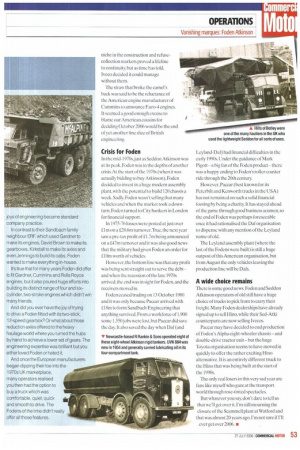206 seems the deal year to bring down the curtain
Page 52

Page 53

If you've noticed an error in this article please click here to report it so we can fix it.
on Foden. It will be exactly 150 years since Edwin Foden (son of a shoemaker, staunch Methodist, great engineer and lover of music) started the evolution of what is claimed to be the oldest truck manufacturer in the world. Foden has had a great run during which time jt has provided employment for huge numbers of people living around Sand bach, and its vehicles have given valiant service to many around the world. Nothing lasts forever, so things have fallen just right haven't they?
If you believe that, then whatever you do, keep it under your hat and do not repeat it within earshot of anyone who has the slightest bit of feeling towards this huge piece of British transport heritage. We are still hoping Paccar will change its mind.
Perhaps it is true that in its 150 years Foden has endured ups and downs and could well have gone out of production several times before. In the early 1930s things became so bad that Edwin Richard Foden (second son of the founder) decided the company was sliding towards extinction and left to work for rival vehicle manufacturer ERF.
It was perhaps fortunate that William Foden (eldest son of the founder) cancelled his dream of making a new life as a farmer in Australia. Poor management and frightening financial losses (at a time when the country was struggling to get Over the late 19205 recession) should have taken Foden down, but William saved the day. He remained a governing director until he died in 1964 aged 96.
The 1930s crisis was created by Foden's inability to adapt to change. Its heritage of brilliance in engineering was something of a huge cross to bear.
At times, it can be very cliff icult to realise how life has left you behind. Foden might have been market leader in steam-powered vehicle production, but by the early 1930s, most operators were opting for diesel power.
Even when William managed to drag Foden into accepting this aspect of change, the company continued to insist on making vehicles its own way.
True, it had become a publicly listed company in 1902, but the strength the Foden family still held over the business meant the joys of engineering became standard company practice.
In contrast to their Sandbach family neighbour ERF, which used Gardner to make its engines, David Brown to make its gearboxes, Kirkstali to make its axles and even Jennings to build its cabs, Foden wanted to make everything in-house.
It's true that for many years Foden did offer to fit Gardner. Cummins and Rolls Royce engines, but it also poured huge efforts into building its distinct range of four and sixcylinder, two-stroke engines which didn't win many friends.
And did you ever have the joy of trying to drive a Foden fitted with its two-stick, 12-speed gearbox? Or what about those reduction axles offered to the heavy haulage world where you turned the hubs by hand to achieve a lower set of gears. The engineering expertise was brilliant but you either loved Foden or hated it.
And once the European manufacturers began dipping their toe into the 1970s UK marketplace, many operators realised you then had the option to buy a truck which was comfortable, quiet, quick and smooth to drive. The Fodens of the time didn't really offer all those features.
























































































































































































